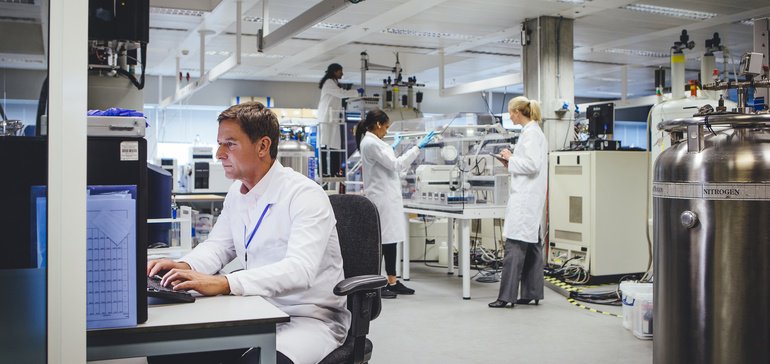SAN FRANCISCO — Developing new medicines isn’t a resource-efficient endeavor.
Estimates vary, but most molecules selected to begin clinical development won’t end up on pharmacy shelves or in doctor’s offices. By some recent signs, drugmakers are finding it harder and harder to hit on a therapy-to-be. Return on R&D investment hit a nine-year low in 2018, numbers recently crunched by Deloitte show.
Still, finding the next blockbuster is the lifeblood of biotech and pharmaceutical companies, motivating billions of dollars in research spending and dealmaking.
Simplify Your Clinical Trial Process
eConsent forms can help get clinical trials off the ground faster, while also improving compliance, enrollment and retention of participants. Get tips for implementing eConsent into your trials, plus testimonials in our webinar.
Learn more
At this year’s J.P. Morgan Healthcare Conference, a number of drugmakers made the case that new technologies, such as cell and gene therapy or RNA-targeted therapeutics, could speed development times and lower costs.
“Historically, we’ve been in a world of small molecules and large molecules,” said Novartis CEO Vas Narasimhan in a presentation at the conference. “My goal over the course of this past year has been to expand the game board. Can we actually now build pillars [of research] in cell therapy?”
Companies like Moderna Therapeutics, Ionis Pharmaceuticals and Sarepta Therapeutics, meanwhile, justify multi-billion dollar valuations by their self-described ability to move quickly from identifying one candidate to the next.
“This has never been about one drug getting to market, but about a lot of medicines getting to patients,” said Stéphane Bancel, CEO of Moderna, in a presentation at JPM.
That promise mostly remains just that, though. Ballooning pipelines aside, the metric that ultimately matters is whether new drugs win approval. The hurdles to get there remain daunting, as forging new ground in cell and gene therapy brings fresh challenges.
And for each technology now receiving renewed attention — gene therapy, cell therapy, RNA-targeting medicines — the track record isn’t long.
Only one gene therapy for an inherited disease is approved in the U.S., although several look set to join Spark Therapeutics’ Luxturna on the market. Two CAR-T cell therapies have reached patients. More RNA therapeutics are available, but not all have been commercial successes.
Gene therapy ambitions
Sarepta is perhaps best known for the controversial approval it won from the Food and Drug Administration for its Duchenne muscular dystrophy drug Exondys 51.
Recently, though, outside attention has centered on the company’s efforts in gene therapy, where promising early results from four treated boys have raised hopes and expectations for a major treatment advance.
Gene therapy is also at the heart of Sarepta’s ambitions to rank as a top rare disease biotech. The company’s pipeline lists 14 gene therapy programs. Most are preclinical, but several are in early clinical stages.
Sarepta argues it can move faster in developing gene therapies than with traditional small molecules or biologics — due to a combination of genetically defined targets, small patient populations and regulatory tailwinds.
“In the context of a gene construct or an RNA therapeutic, you can identify a target and select the best molecule or gene construct to go after that in a substantially compressed timeframe,” said Gilmore O’Neill, Sarepta’s chief medical officer, in an interview.
“These are huge opportunities,” O’Neill added. “With the smaller numbers, smaller cost and lower risk, you can actually afford to do many of these activities in parallel whereas before you’d have staged them in series.”
Gene therapy studies can be smaller, particularly in rare diseases, in part because the expected treatment effects are large and therefore require fewer patients to demonstrate efficacy.
That’s been the experience for Novartis, which quickly moved to file a gene therapy for spinal muscular atrophy after acquiring its biotech developer AveXis last spring.
Clinical evidence for Zolgensma comes from a Phase 1 study testing the treatment in just 15 infants. Data showed all 15 were alive and off permanent ventilation in two years, a result typically unattainable in the usual course of the fatal neuromuscular disorder.
“What’s exciting about this space is we’ve proven with SMA Type 1 that truly compelling data with a single Phase 1 trial you can get to registration,” Narasimhan said. “You really change the dynamic in terms of R&D investment and timelines when you can bring that kind of transformative efficacy to patients.”
Gene therapy brings fresh challenges, however, not least of which is figuring out how to reliably make the DNA-based treatments at scale. Unlike small molecules or biologics, manufacturing for gene therapies remains a work in progress. Shortages in supply of the viral vectors used to deliver the therapies in humans, for example, is one hurdle still confronting developers.








